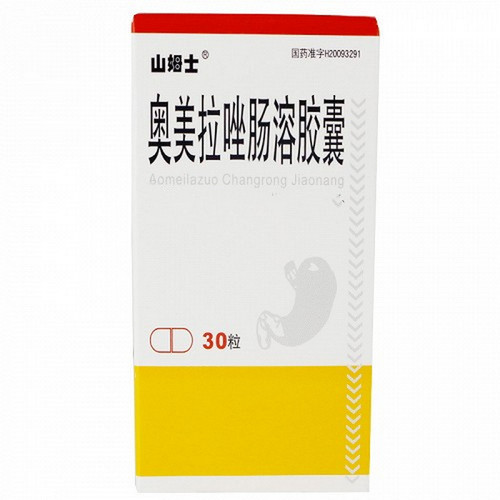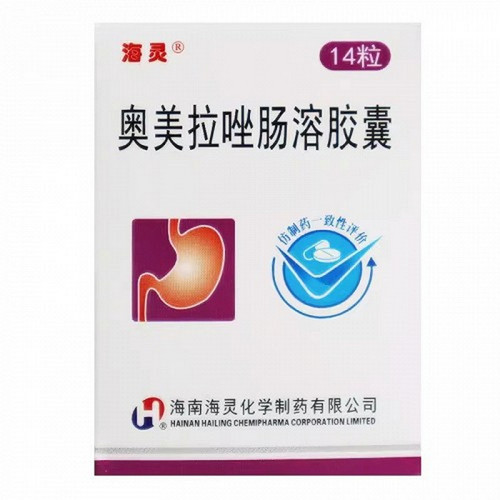Product Overview
[Drug Name]
Omeprazole and Sodium Bicarbonate Capsules
[Main Ingredients]
This product is a compound immediate-release preparation. Each capsule contains 20 mg of omeprazole and 1100 mg of sodium bicarbonate. Omeprazole Chemical Name: 5-Methoxy-2-(4-methoxy-3,5-dimethyl-2-pyridyl)methyl]sulfinyl]-1H-benzimidazole. Molecular Formula: C₁₇H₁₇N₃₅O₃₅. Molecular Formula: NaHCO₃. Molecular Weight: 345.42. Sodium Bicarbonate Molecular Formula: NaHCO₃. Molecular Weight: 84.01.
[Properties]
This product is a white or off-white powder.
[Indications/Main Functions]
1. For the short-term treatment of active duodenal ulcers. Most patients heal within 4 weeks. Some patients may require an additional 4 weeks of treatment. 2. Gastroesophageal Reflux Disease: This medication is used to treat heartburn and other symptoms caused by gastroesophageal reflux disease for up to 4 weeks. It is also used for the short-term treatment of reflux esophagitis diagnosed by endoscopy (4-8 weeks). The efficacy of this medication for use beyond 8 weeks has not been established. If the patient does not improve after 8 weeks of treatment, treatment can be continued for an additional 4 weeks. If reflux esophagitis or gastroesophageal reflux disease symptoms (such as heartburn) recur, this medication may be considered for an additional 4-8 weeks of treatment. It is used for maintenance treatment after resolution of reflux esophagitis. Controlled clinical trials have not exceeded 12 months.
[Specifications]
7 capsules
[Dosage and Administration]
Due to the sodium bicarbonate content of this product, two 20 mg (based on omeprazole content) capsules cannot be used interchangeably with one 40 mg (based on omeprazole content) capsule. Dosage: Table 1 Recommended Dosage for Adults 18 Years and Older (Based on Omeprazole Content). Indication: Treatment of active duodenal ulcers; Recommended dose: 20 mg (1 capsule) once daily; Treatment duration: 4 weeks*. Indication: Gastroesophageal Reflux Disease. Indication: Treatment of symptoms of gastroesophageal reflux disease; Recommended dose: 20 mg (1 capsule) once daily; Treatment duration: Up to 4 weeks. Indication: Treatment of reflux esophagitis; Recommended dose: 20 mg (1 capsule); Treatment duration: Once daily for 4 to 8 weeks**. Indication: Maintenance of healing of reflux esophagitis; Recommended dose: 20 mg (1 capsule) once daily; Treatment duration: Controlled trials have not exceeded 12 months. *Most patients heal within 4 weeks. Some patients may require an additional 4 weeks of treatment. **The efficacy of this drug for patients with reflux esophagitis beyond 8 weeks has not been established. If the patient does not improve after 8 weeks of treatment, treatment may be continued for an additional 4 weeks. If symptoms of reflux esophagitis or gastroesophageal reflux disease (e.g., heartburn) recur, consider continuing this drug for an additional 4 to 8 weeks. Directions: Swallow whole with water. Do not use other liquids and do not open the capsules. This drug should be taken on an empty stomach at least 1 hour before a meal.
[Adverse Reactions]
See package insert for details.
[Contraindications]
This drug is contraindicated in patients with hypersensitivity to benzimidazoles or any of the ingredients in this drug. Hypersensitivity reactions may include anaphylaxis, anaphylactic shock, angioedema, bronchospasm, acute tubulointerstitial nephritis, and urticaria. Proton pump inhibitors (PPIs), including this drug, are contraindicated in patients receiving products containing rilpivirine.
[Precautions]
1. Even in adult patients with gastric malignancies whose symptoms resolve with this drug, the possibility of gastric malignancy cannot be ruled out. Adult patients who experience suboptimal remission or recurrence of early symptoms after PPI therapy should consider additional follow-up and diagnostic testing. For elderly patients, endoscopy should be considered. 2. Acute Tubulointerstitial Nephritis: Acute tubulointerstitial nephritis (TIN) has been observed in patients taking PPIs and may occur at any time during PPI treatment. Patients may experience a variety of signs and symptoms, ranging from symptomatic hypersensitivity reactions to nonspecific symptoms of decreased renal function (e.g., malaise, nausea, and anorexia). In reported case series, some patients were diagnosed by biopsy without extrarenal manifestations (e.g., fever, rash, or arthralgia). If acute TIN is suspected, discontinue this product (see [Contraindications]). 3. Sodium Bicarbonate Buffer: Each 20 mg or 40 mg omeprazole sodium bicarbonate capsule contains 110 mg of sodium bicarbonate (equivalent to 13 mE), with a total sodium content of 304 mg per capsule. Long-term administration of bicarbonate with calcium or milk can cause milk-alkali syndrome. Long-term use of sodium bicarbonate may cause systemic alkalosis, and increased sodium intake can lead to edema and weight gain. Sodium intake should be considered when using this product in patients on a sodium-restricted diet or at risk for congestive heart failure. This product should be avoided in patients with Bartter's syndrome, hypokalemia, hypocalcemia, and acid-base disorders. 4. Clostridium difficile-Associated Diarrhea: Published observational studies suggest that PP (including this product) therapy may increase the risk of Clostridium difficile diarrhea, particularly in hospitalized patients. This diagnosis should be considered if diarrhea does not improve (see Adverse Reactions). Patients should receive the lowest dose and shortest duration of PP therapy appropriate for their medical condition. 5. Fractures: Multiple published observational studies suggest that PP therapy may increase the risk of osteoporosis-related fractures (hip, wrist, or spine). Patients receiving high-dose (defined as multiple daily doses) and long-term (one year or longer) PP therapy have an increased risk of fractures. Patients should receive the lowest dose and shortest duration of PP therapy appropriate for their medical condition. Patients at risk for osteoporosis-related fractures should be managed according to relevant treatment guidelines. 6. Cutaneous lupus erythematosus (CL) and systemic lupus erythematosus (SLE) have been reported in patients treated with PPIs (including omeprazole). These events include new cases or exacerbations of pre-existing autoimmune diseases. PPI-induced lupus erythematosus primarily involves CLE. The most commonly reported form of CLE in patients treated with PPIs is subacute CLE (SCLE), which typically occurs weeks to years after continuous drug treatment and ranges from infants to the elderly. Generally, histological examinations do not reveal organ involvement. Systemic lupus erythematosus (SLE) is less common in patients treated with PPIs than CLE. PPI-related SLE is generally milder in severity than non-drug-induced SLE. SLE typically develops within days to years after the start of treatment and ranges from young to elderly patients. Most patients present with a rash; however, arthralgia and cytopenias have also been reported. Avoid using PPIs beyond the prescribed course of treatment. If signs or symptoms of CLE or SLE are observed in patients taking this product, discontinue the drug and refer the patient to an appropriate specialist for evaluation. Most patients improve within 4 to 12 weeks after discontinuing the PI alone. Serological tests (such as ANA) may be positive, and the time it takes for serological test results to return to normal may be longer than the time it takes for clinical remission. 7. Interaction with Clopidogrel: Avoid co-administration of this product with oxypidogrel. Clopidogrel is a prodrug, and its active metabolite inhibits platelet aggregation. When co-administered with drugs such as omeprazole, the latter inhibits CYP2C19 activity, which may affect the metabolism of clopidogrel to its active metabolite. Co-administration of clopidogrel and 80 mg of omeprazole may reduce the pharmacological activity of oxypidogrel, even if the two are administered 12 hours apart. When using this product, consider using other antiplatelet agents (see [Drug Interactions]). 8. Cyanocobalamin (Vitamin B12) Deficiency: Long-term (e.g., longer than 3 years) daily treatment with acid-suppressing medications may lead to hypochlorhydria or achlorhydria, subsequently causing vitamin B12 malabsorption. There have been rare reports of cyanocobalamin deficiency associated with acid-suppressing therapy. This diagnosis should be considered if clinical symptoms consistent with cyanocobalamin deficiency are observed. 9. Hypomagnesemia: Rare cases of asymptomatic and symptomatic hypomagnesemia have been reported in patients treated with PP for at least 3 months (mostly after 1 year of treatment). Serious adverse events include tetany, cardiac arrhythmias, and seizures. For most patients, correction of hypomagnesemia requires magnesium supplementation and discontinuation of PPIs. If prolonged PP treatment is anticipated or if concomitant medications such as digoxin or drugs that may cause hypomagnesemia (e.g., diuretics) are being taken, consider monitoring serum magnesium levels before and during treatment. 10. Concomitant use of drugs that induce CYP2C19 or CYP3A4 (such as St. John's wort or rifampin) may significantly decrease omeprazole plasma concentrations. Avoid co-administration of this product with St. John's wort or rifampin. 11. Interaction with Diagnostic Tests for Neuroendocrine Tumors: Serum chromogranin A (CgA) levels may increase secondary to drug-induced decreases in gastric acid. Elevated CgA levels can lead to false-positive results in diagnostic tests for neuroendocrine tumors. Omeprazole should be withheld for at least 14 days before evaluating blood CgA levels. If the initial CgA level is elevated, rechecking this indicator should be considered. Because normal reference values may vary between laboratories, serial testing (e.g., monitoring) should be performed in the same laboratory. 12. Concomitant Use of Methotrexate: Literature suggests that concomitant use of PP and methotrexate (primarily high doses; see methotrexate package insert) may increase the blood concentrations of methotrexate and/or its metabolites and prolong their duration, potentially leading to methotrexate toxicity. Some patients taking high-dose methotrexate should consider discontinuing PPI use (see [Drug Interactions]). 13. Fundic Gland Polyps: Long-term PPI use is associated with an increased risk of fundic gland polyps, especially if continued for more than one year. Most fundic gland polyps in PPI users are asymptomatic and are discovered incidentally during endoscopy. Patients should receive the shortest possible course of PPI therapy based on their medical condition. 14. Dose reduction should be considered in patients with hepatic impairment, especially those undergoing maintenance therapy for reflux esophagitis during its healing phase. 15. Dose reduction is recommended in Asian populations, especially for those undergoing maintenance therapy for reflux esophagitis during its healing phase.






